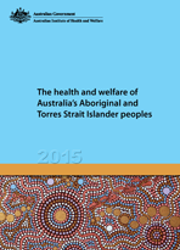This is the eighth report in an Australian Institute of Health and Welfare (AIHW) series that covers topics regarded as important for the improvement of the health and welfare of Aboriginal and Torres Strait Islander people. Until 2008, these reports were prepared jointly with the Australian Bureau of Statistics (ABS) (ABS & AIHW 2008). The first report produced solely by the AIHW was released in 2011 (AIHW 2011b).
This report aims to provide a comprehensive picture of the health and welfare of Australia’s Indigenous population, presenting the latest information on a range of topics including key demographic and economic characteristics, factors that influence health, main conditions causing ill health and mortality, life expectancy and mortality patterns, service use, and health and welfare expenditure. Some of the links between education, employment and health are also explored, as are links between selected risk factors and health.
The timing of publication of this edition intentionally allowed for the inclusion of information from the 2011 Census of Population and Housing, as well as the 2012–13 Australian Aboriginal and Torres Strait Islander Health Survey (AATSIHS). The report also draws on the most recent information available from a number of administrative data collections held by the AIHW, as well as from a large number of other data sources.
Throughout this report, a particular emphasis is placed on describing differences among Indigenous Australians that are associated with where they live. Although, like the Australian population at large, the majority of Indigenous Australians live in cities located along the east coast, they make up almost half of the total number of people who live in Very remote areas. The tendency for Indigenous Australians to live in Remote and Very remote areas can create particular challenges in a number of areas, including employment, housing, and the delivery of health care and welfare services
The 8 chapters of this report cover the following topics:
1. Introduction
2. The Indigenous population Key points
- describes demographic characteristics, household composition and cultural identification
- includes information about Torres Strait Islander people.
3. Economic participation, housing and community safety Key points
- describes economic participation including education, employment and access to economic resources
- provides information about housing, homelessness and community safety.
4. Determinants of health Key points
- looks at various factors that influence health including behavioural, biomedical, psychological, and socioeconomic and environmental factors.
5. Health and disability Key points
- describes self-assessed health status
- details the prevalence of major health conditions and provides information on service use for these conditions
- describes the prevalence of disability.
6. Life expectancy and mortality Key points
- provides details about life expectancy and mortality patterns, including the main causes of death
- describes overall trends in mortality, as well as for various age groups.
7. Health and welfare services Key points
- details the use of health and welfare services.
8. Expenditure and workforce Key points
- outlines expenditure on health and welfare
- describes participation in the health and community services workforces.
Appendixes:
Appendix A: Data quality and key data sources
Appendix B: Methods and technical notes
Appendix C: Description of selected measures in the 2012–13 Australian Aboriginal and Torres Strait Islander Health Survey
Appendix D: Disability data



